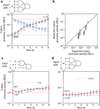Genetic programs constructed from layered logic gates in single cells
- PMID: 23041931
- PMCID: PMC3904217
- DOI: 10.1038/nature11516
Genetic programs constructed from layered logic gates in single cells
Abstract
Genetic programs function to integrate environmental sensors, implement signal processing algorithms and control expression dynamics. These programs consist of integrated genetic circuits that individually implement operations ranging from digital logic to dynamic circuits, and they have been used in various cellular engineering applications, including the implementation of process control in metabolic networks and the coordination of spatial differentiation in artificial tissues. A key limitation is that the circuits are based on biochemical interactions occurring in the confined volume of the cell, so the size of programs has been limited to a few circuits. Here we apply part mining and directed evolution to build a set of transcriptional AND gates in Escherichia coli. Each AND gate integrates two promoter inputs and controls one promoter output. This allows the gates to be layered by having the output promoter of an upstream circuit serve as the input promoter for a downstream circuit. Each gate consists of a transcription factor that requires a second chaperone protein to activate the output promoter. Multiple activator-chaperone pairs are identified from type III secretion pathways in different strains of bacteria. Directed evolution is applied to increase the dynamic range and orthogonality of the circuits. These gates are connected in different permutations to form programs, the largest of which is a 4-input AND gate that consists of 3 circuits that integrate 4 inducible systems, thus requiring 11 regulatory proteins. Measuring the performance of individual gates is sufficient to capture the behaviour of the complete program. Errors in the output due to delays (faults), a common problem for layered circuits, are not observed. This work demonstrates the successful layering of orthogonal logic gates, a design strategy that could enable the construction of large, integrated circuits in single cells.
Figures





References
-
- Wang B, Kitney RI, Joly N, Buck M. Engineering modular and orthogonal genetic logic gates for robust digital-like synthetic biology. Nature Commun. 2011;2:508. http://dx.doi.org/10.1038/ncomms1516. - DOI - PMC - PubMed
Publication types
MeSH terms
Substances
Grants and funding
LinkOut - more resources
Full Text Sources
Other Literature Sources

